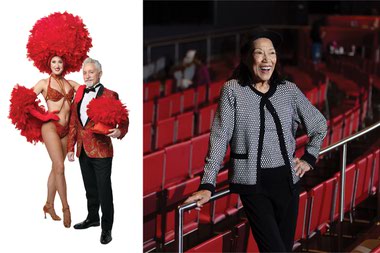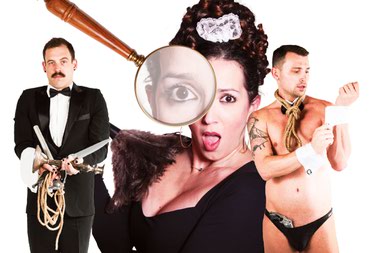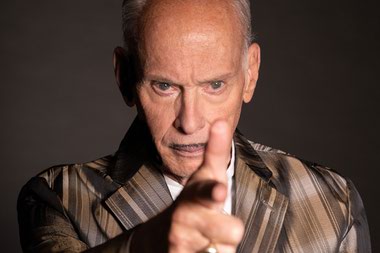There was a period when pushing Shakespeare into implausible circumstances was a matter of fashion. Many have pointed out that the Bard himself would have approved of updated approaches to his work, especially given the dearth of stage directions in his plays. But if your directorial predilections lead you to put Romeo in a motorcycle gang or dress the eponymous couple like the Cat in the Hat, maybe you should just download West Side Story and be done with it.
This is not what's going on at the Erotic Heritage Museum starting July 17. Staging three back-to-back productions at the museum, Insurgo Theater Movement is building on its growing positive reputation by doing what good theater does: taking comprehensible risks.
Over the phone, director John Beane explains through an audible grin, "We're coming at the play as an original work, looking to the text and not previous productions, which is probably what everyone says." Trying to avoid inflicting an agenda on a classic turns out to be a hefty job when taking on the summer stock favorite A Midsummer Night's Dream. Add to that the erotic context and venue and the production could've ended up as the basis for a Producers sequel.
When Beane got a call from the director of the Erotic Heritage Museum, Laura Henkel, about staging something there, he didn't hesitate. "The venue gives the play a good framework through which an audience can be introduced to the themes we want to explore more closely," explains Beane.
The Details
- Erotic Shakespeare: A Midsummer Night's Dream
- Fridays, 10:30 p.m., Saturdays, 8 p.m., July 17-Aug. 7
- at the Erotic Heritage Museum, $25
- eroticheritage.org
The exuberant and blond Henkel recounts that after seeing Insurgo perform, she realized "they represent incredible talent and vision." Inspired by Shakespeare's Red Light District roots, Henkel felt, "Insurgo wouldn't be afraid to present the play's eroticism in a sophisticated, yet powerful way."
But Beane is careful to add, "the erotic is really only one of these themes. The play runs the whole spectrum of love, from the unrequited, in Helena and Hermia, to the voyeuristic, in Oberon and Puck, to the jealous and covetous."
Anxious to see a rehearsal, I showed up at the dilapidated New Orleans Square, where Insurgo has its home. Beane greeted me with his sonorous radio voice and looked every inch the engaged director with his black button-down, combat boots and full beard. The cast was in the middle of rehearsing the famed "Pyramus and Thisbe" play within a play, and I got a look at how a true ensemble collaborates.
Beane and his group seem to have a talent for coaxing fresh perspectives out of often-performed classics without losing site of the work itself, no doubt the result of these collaborations. "What many productions of this play don't acknowledge are the extreme and dark things going on: Hermia and Demetrius end the play as different people than they started out as, which is ambiguous at best," says Beane. Focusing on the fairy King Oberon's original words about the problematic potion incorrectly administered by Puck, Insurgo's inspiration lingers on what exactly it means to "madly dote" and how that would manifest itself physically.
The physical is part of what makes this production surprising. However, the uber-energetic Michael Kimm, who plays Lysander, is quick to point out, "The way they teach this play in school doesn't really do its physical eroticism justice." I get to see many instances of this at another rehearsal, this time in the museum. From Scene 1, animal sensuality and violence take shape in the wild Hippolyta's attempts to escape the relentless Duke, her would-be husband. But not all the blocking is so rough. Titania's classical beauty and the pure sensuality with which the lithe Mindy Woodhead plays her speak of both strength and grace, and Puck jumps from rooftops as fairies glide through elaborately choreographed dances.
"It helps that I have the luxury of working with athletes who are cleverly disguised as regular people," says Beane. Often going to physical extremes in both the love scenes and scenes of violence, Insurgo's version occasionally blends the two in S&M-type scenarios that illustrate the work's power dynamics. The nimble Megan Koumis plays the Amazonian warrior Hippolyta (who is in bondage throughout the first scene) as won only by Theseus's sexual force. The audience is witness as he hunts her like an animal and picks her up, throwing her down on the ground and having at her. Startlingly this dominance inspires a change of heart and she submits, squirming under his masculine possession of her with a sly smile of pleasurable resignation.
Bottom is also explicitly taken by force and straddled and molested into submission by the nude fairy queen and her minions, who spend their time rubbing themselves against and stroking her when they're not caressing each other or manhandling Bottom. But Helena (acted by Rosalie Miletich) is the worst victim of sexual aggression gone mad, explicitly raped before the audience's eyes.
Beyond fierce scenes of sexual overpowering, at least one well-endowed character appears completely nude and many others nearly so, some in outfits made entirely of cellophane. One such steamy scene occurs early on between Lysander and Hermia, when he lifts her as they disrobe and she straddles him and kisses him frantically. They fall into sincere near-sex on a forest bed, as she sighs and moans with pleasure, nearly giving up her virginity minutes before he abandons her. This intentional shift toward extreme sensual passion and away from the usual approach of highlighting the lighter and more comedic dialogue is unique. It seems to reinforce that feeling that audiences sometimes have at the end of many of Shakespeare's comedies: Is everything really all right in the final scene after all that's happened?
While Insurgo's version would decidedly answer "No," it is not without its thoroughly comedic moments, with the Pyramus and Thisbe scene as a prime illustration. Each new stage direction issued by Beane guided the cast members through a trial-and-error blocking process that often originated in welcome suggestions from the actors themselves. There's such a friendly rapport between director and cast that the hierarchical working relationship most of us envision in a theater seems as fluid as the performances.
One's scene-stealing abilities and tirelessness must be highlighted, though. Ernie Curcio portrays Bottom with such a genuinely bombastic spirit that it's hard to remember how the weaver was ever played before. Watching the compact, dark Curcio, you'd never know that he says, "I usually play the villain like my last role as Iago…this is a great part because Bottom's so sincere and in the moment."
Drawing genuine belly laughs from me, despite my embarrassment at being the only non-Insurgo member at the rehearsal, Curcio roars his way through Bottom's idea of good acting with gusto. Attempting to curb some of what Beane refers to as "manic energy," he reminds the actor about the lines' lyrical rhythms, a point Curcio takes as most take a compliment and proceeds to perform an even funnier version of the scene.
Beane argues that "the meter of the poetic text itself is suggestive of all types of extreme emotion reinforced in movement. Shakespeare wrote in a rhythm the body and heart understand. A good actor can choose to tap into that." Experiencing the visceral side of Shakespeare could be something that makes his work more accessible to a larger audience, not to mention more engaging to watch.
Plays like Love's Labour's Lost (which Insurgo also tackled recently) are better known for tongue-twisting dialogue and lengthy soliloquies than passionate characters. Placing Shakespeare fully in the context of the erotic leaves little room for confusion, especially if, as I've discovered with this production of A Midsummer Night's Dream, the actors are as physically engaged in their scenes as they are emotionally.







Previous Discussion: